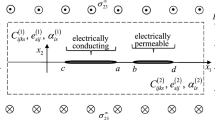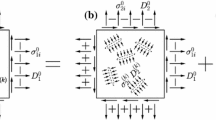Abstract
Cracks and porosities inside the piezoelectric materials can weaken the electromechanical coupling effect, and hence influence the electromechanical coupling behavior of piezoelectric materials considerably. This paper studies the effect of internal cracking on the effective properties of piezoelectric media. It focuses on the piezoelectric medium of finite size with finite crack. The mechanical and electric fields in the piezoelectric material and the crack are formulated by singular integral method. Effects of crack size, medium border, and electric permeability of the crack on the overall electromechanical properties of the piezoelectric material are obtained and displayed graphically. In addition, the crack tip coupling electromechanical field intensity factors are also presented as they are not available in open literature for a finite crack in a finite piezoelectric media.
Similar content being viewed by others
References
Beom HG, Kim YH, Cho C, Kim CB (2006a) A crack with an electric displacement saturation zone in an electrostrictive material. Arch Appl Mech 76: 19–31
Beom HG, Kim YH, Cho C, Kim CB (2006b) Asymptotic analysis of an impermeable crack in an electrostrictive material subjected to electric loading. Int J Solids Struct 43: 6869–6886
Busche MJ, Hsia KJ (2001) Fracture and domain switching by indentation in barium titanate single crystals. Scripta Mater 44: 207–212
Chen W, Lynch CS (1998) A micro-electro-mechanical model for polarization switching of ferroelectric materials. Acta Mater 46: 5303–5311
Fu R, Zhang TY (2000) Effects of an electric field on the fracture toughness of poled lead zirconate titanate ceramics. J Am Ceram Soc 83: 215–1218
Gao H, Barnett DM (1996) An invariance property of local energy release rate in a strip saturation model of piezoelectric fracture. Int J Fract 79: R25–R29
Gao H, Zhang TY, Tong P (1997) Local and global energy release rates for an electrically yielded crack in a piezoelectric ceramic. J Mech Phys Solids 45: 491–510
Giannakopoulos AF, Suresh S (1999) Theory of indentation of piezoelectric materials. Acta Mater 47: 2153–2164
Govorukha VB, Loboda VV, Kamlah M (2006) On the influence of the electric permeability on an interface crack in a piezoelectric bimaterial compound. Int J Solids Struct 43: 1979–1990
Gruebner O, Kamlah M, Munz D (2003) Finite element analysis of cracks in piezoelectric materials taking into account the permittivity of the crack medium. Eng Fract Mech 70: 1399–1413
Hao TH, Shen ZY (1994) A new electric boundary condition of electric fracture mechanics and its applications. Eng Fract Mech 47: 793–802
Herrmann KP, Loboda VV, Govorukha VB (2001) On contact zone models for an electrically impermeable interface crack in a piezoelectric biomaterial. Int J Fract 111: 203–227
Hwang SC, Lynch CS, McMeeking RM (1995) Acta Metall Mater 43: 2073
Jeong KM, Kim IO, Beom HG (2004) Effect of electric displacement saturation on the stress intensity factor for a crack in a ferroelectric ceramic. Mech Res Commun 31: 371–382
Landis CM (2004) Electrically consistent boundary conditions for electromechanical fracture. Int J Solids Struct 41: 6291–6315
Lapusta Y, Loboda V (2009) Electro-mechanical yielding for a limited permeable crack in an interlayer between piezoelectric materials. Mech Res Commun 36: 183–192
Li S (2003) On saturation-strip model of a permeable crack in a piezoelectric ceramic. Acta Mech 165: 47–71
Li W, McMeeking RM, Landis CM (2008) On the crack face boundary conditions in electromechanical fracture and an experimental protocol for determining energy release rates. Eur J Mech A/Solids 27: 285–301
Loboda V, Lapusta Y, Sheveleva A (2007) Electro-mechanical pre-fracture zones for an electrically permeable interface crack in a piezoelectric biomaterial. Int J Solids Struct 44: 5538–5553
Loboda V, Lapusta Y, Govorukha V (2008) Mechanical and electrical yielding for an electrically insulated crack in an interlayer between piezoelectric materials. Int J Eng Sci 46: 260–272
Needleman A (1990) An analysis of tensile decohesion along an interface. J Mech Phys Solids 38: 289–324
Nied HF (1987) Periodic array of cracks in a half plane subjected to arbitrary loading. ASME J Appl Mech 54: 642–648
Parton VZ (1976) Fracture mechanics of piezoelectric materials. Acta Astronaut 3: 671–683
Parton VZ, Kudryavtsev BA (1988) Electromagnetoelasticity. Gordon and Breach Science Publishers, New York
Rajapakse RKND, Zeng X (2001) Acta Mater 49: 877
Ru CQ (1999) Effect of electrical polarization saturation on stress intensity factors in a piezoelectric ceramics. Int J Solids Struct 36: 869–883
Ru CQ, Mao X (1999) Conducting crack in a piezoelectric ceramics of limited electrical polarization. J Mech Phys Solids 47: 2125–2146
Schneider GA, Heye V (1999) J Eur Ceram Soc 19: 1299
Shindo Y, Murakami H, Horiguchi K et al (2002) Evaluation of electric fracture properties of piezoelectric ceramics using the finite element and single-edge precracked-beam methods. J Am Ceram Soc 85: 1243–1248
Shindo Y, Narita F, Horiguchi K et al (2003) Electric fracture and polarization switching properties of piezoelectric ceramic PZT studied by the modified small punch test. Acta Mater 51: 4773–4782
Shindo Y, Narita F, Mikami M (2005) Double torsion testing and finite element analysis for determining the electric fracture properties of piezoelectric ceramics. J Appl Phys 97: 114109
Sun CT, Park SB (2000) Ferroelectrics 248: 79
Suo Z, Kuo CM, Barnett DM, Willis JR (1992) Fracture mechanics for piezoelectric ceramics. J Mech Phys Solids 40: 739–765
Turner MR, Evans AG (1996) An experimental study of the mechanisms of crack extension along an oxide/metal interface. Acta Mater 44: 863–871
Wang TC (2000) Analysis of strip electric saturation model of crack problem in piezoelectric materials. Int J Solids Struct 37: 6031–6049
Wang BL, Mai YW (2003) On the electrical boundary conditions on the crack surfaces in piezoelectric ceramics. Int J Eng Sci 41: 633–652
Zhang TY, Gao CF (2004) Fracture behavior of piezoelectric materials. Theor Appl Fracture Mech 41: 339–379
Author information
Authors and Affiliations
Corresponding author
Rights and permissions
About this article
Cite this article
Wang, B.L., Han, JC. Effect of finite cracking on the electromechanical coupling properties of piezoelectric materials. Int J Fract 164, 201–212 (2010). https://doi.org/10.1007/s10704-010-9474-9
Received:
Accepted:
Published:
Issue Date:
DOI: https://doi.org/10.1007/s10704-010-9474-9




